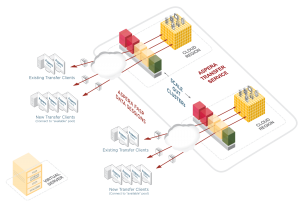SVG Europe Sit-Down: Aspera’s Andrea di Muzio on cloud misconceptions, security safeguards and partnership priorities
According to Aspera, the live sports genre prizes high definition quality more than most other areas of broadcasting. And that means broadcasters realise the need to fully optimise their transfer capacity with high-performance file transport.
Recent enhancements to the Aspera Files service have meant that the fast and secure sharing and distribution of large files and datasets via the IBM Cloud have been simplified. However, that has not been the only significant innovation from the company in the past few months. In a comprehensive interview, Aspera director of professional solutions Andrea di Muzio begins by enthusiastically talking about those innovative introductions.
What have been the latest developments in the file transfer market?
With the arrival of 4K and 8K, and the need to deliver more content in numerous formats for multi-platform distribution, file sizes and the volume of content that media companies need to exchange are soaring. At the same time, they face shorter turnaround times and must collaborate both internally and externally to survive in this highly competitive market. This makes the cloud’s promise of unlimited, on-demand increases in storage, computing, and bandwidth a highly attractive, future-proof option. Consequently, media companies are looking to replace their existing cumbersome content sharing techniques with hybrid cloud and software-as-a-service solutions for securely and easily sharing large media content with maximum speed, in predictable times, and over any distance independent from storage location.
Aspera launched the Aspera Files Software as a Service (SaaS) offering to address these needs, accelerating the sharing and secure transfer of content files and associated metadata directly from their native storage environments – whether on premises or in the cloud. At BVE 2017, we announced enhancements to Aspera Files designed to further simplify the fast and secure sharing and distribution of large files and datasets via the IBM Cloud.
The new Aspera Files Express mode dramatically simplifies large content sharing, sending and receiving with an ultra-simple user interface. Users can switch between full Files and Files Express mode with one click of the toggle switch in the app.
In addition, Files now includes built-in support for the new hosted multi-cloud IBM Aspera High-Speed Transfer Service (ATS), a hybrid multi-tenant service for fast and secure big data transfers to, from, and across cloud object storage systems, seamlessly connecting public and private clouds with on-premises infrastructure. ATS provides high availability and automatic scale-out supporting data transfers with cloud storage at up to 20 Gbps per region from any distance, and providing back-of-cloud services to meet variable demands, significantly reducing operational complexity.
Adoption of the innovative Aspera Files SaaS and ATS is accelerating, driven by the continued growth in file sizes and data sets and the need to securely share those files across remote teams.
Have users really come to understand what we mean by ‘the cloud’?
Users are increasingly aware of the cloud and its potential benefits, but there are still some misconceptions. One of the biggest hurdles to moving media workflows to the cloud is the delay that transferring large content files to the cloud can introduce. Shipping physical disks is time consuming, expensive and exposes valuable content to unnecessary security risks, while traditional transfer software technologies are slow and unreliable.
Media companies need a high-speed transport mechanism that addresses two main bottlenecks — the degradation in WAN transfer speeds that occurs over distance using traditional transfer protocols, and the ‘last foot’ bottleneck inside the cloud data centre caused by the HTTP interfaces to the underlying object-based cloud storage.
Our cloud solutions feature Aspera’s patented FASP transfer technology to achieve maximum speed regardless of file size, transfer distance or network conditions, plus Aspera’s unique Direct-to-Cloud capability. By tightly integrating FASP transfers with the native APIs of cloud-based object storage, transferred data is written directly to object storage and available immediately when the transfer completes. This enables users to securely move their data directly into the cloud at line speed over long-haul wide area networks.
Following on from that, how are you educating customers with regards to this technology?
Through a combination of direct conversations with customers and webinars, we’re educating customers about things like the cloud’s technical bottlenecks, the principles of cloud object stores, best practices for orchestrating large-scale cloud workflows, the requirements and challenges of public and private cloud infrastructures, and the role of high-speed direct-to-cloud transport technologies in unlocking the cloud for media workflows.
Cyber security is of concern to all users. What are you doing to ensure the integrity of users’ data?
All Aspera products have complete, built-in security for data transfers using the standard open-source OpenSSL toolkit. The OpenSSL cryptographic libraries and the standard secure shell (SSH2) are used unmodified in order to take full advantage of the standard. Aspera’s products have been approved by the US Department of Commerce for export as a mass-market encryption product with >64-bit encryption.
The security model consists of session encryption (to establish a secure channel for exchanging a random per-session key for data encryption), secure authentication of the transfer endpoints, on-the-fly data encryption, and integrity verification for each transmitted data block. The transfer preserves the native file system access control attributes between any of the supported operating systems.
How do you work in tandem with the likes of EVS and Avid?

Aspera’s patented FASP transfer technology achieves maximum speed regardless of file size, transfer distance or network conditions
Our technology partnership with EVS enables us to deliver complete end-to-end solutions for fast turnaround of live sports, news and entertainment production. The combined solution is based on Aspera’s patented FASP technology for high-speed transfer of content and EVS’ portfolio of live and near-live broadcast applications. By integrating EVS’ live production solutions with Aspera FASP, production no longer has to be co-located at an event. For example, time-critical high-resolution content can be transferred over a wide area network at maximum speed from the sporting venue to a remote facility for editing, and ultimately back to the studio and on to broadcasters for near-live broadcast.
Avid has integrated Aspera FASP into a number of its digital audio and video solutions to facilitate global collaboration. Most recently, Avid integrated Aspera FASP with Avid Interplay | MAM to easily and securely move large media assets globally to and from any location and storage type with greater speed and reliability for coordinated multi-site content creation, management, and distribution.
Which recent European sports projects you can cite as major successes?
At Euro 2016, Aspera FASP was integrated into EVS’ C-Cast platform, which delivered enriched content like multi-angle clips, statistics and infographics to fans’ mobiles. The embedded Aspera FASP high-speed transfer software was used to transfer multi-camera assets through Aspera On Demand software server running in the cloud. During the four-week tournament, UEFA used C-Cast to deliver 45,000 clips to its 25 broadcast partners.
How do you see the future of the file transfer market progressing?
The future of file transfer will see streams and files interoperate for exceptional transport quality and efficiency over today’s networks. Aspera recently innovated a new byte streaming capability in our transport platform on top of FASP for transporting live data. Aspera FASPStream transports any live video source (local multicast, unicast UDP, TCP, or growing file source) and provides timely arrival of live video and data independent of network round-trip delay and packet loss. It delivers high bit rate – meaning high quality – video over the Internet without start-up delay or glitching/buffering, reducing the need for expensive and limited satellite-based backhaul, transport and distribution.

